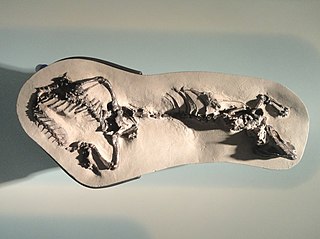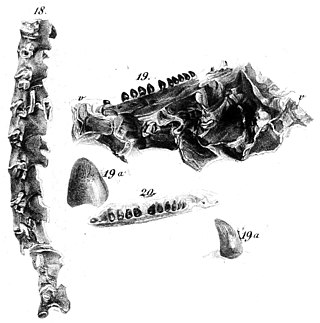
Mosasaurs comprise a group of extinct, large marine reptiles from the Late Cretaceous. Their first fossil remains were discovered in a limestone quarry at Maastricht on the Meuse in 1764. They belong to the order Squamata, which includes lizards and snakes.

Pythonomorpha was originally proposed by paleontologist Edward Drinker Cope (1869) as a reptilian order comprising mosasaurs, which he believed to be close relatives of Ophidia (snakes). The etymology of the term Pythonomorpha comes from the Greek Python and morphe ("form"), and refers to the generally serpentine body plan of members of the group. Cope wrote, "In the mosasauroids, we almost realize the fictions of snake-like dragons and sea-serpents, in which men have been ever prone to indulge. On account of the ophidian part of their affinities, I have called this order Pythonomorpha." Cope incorporated two families, the Clidastidae and the Mosasauridae.
Pachyrhachis is an extinct genus of snake with well developed hind legs known from fossils discovered in Ein Yabrud, near Ramallah, in the central West Bank. It is a relatively small snake, measuring more than 1.5 metres (4.9 ft) long at maximum. Pachyrhachis appears to have been an ancient marine snake; the fossils occur in a marine limestone deposit, and the thickened bone of the ribs and vertebrae would have functioned as ballast to decrease the buoyancy of the animal, allowing it to dive beneath the ancient Cretaceous seas that it once inhabited.

Aigialosauridae is a family of Late Cretaceous semiaquatic pythonomorph lizards closely related to the mosasaurs. Regarded by some paleontologists as a distinct monophyletic group and by others as an adaptive grade within the basal mosasauroids, recent molecular and morphological data suggests that they are the oldest known members of the lineage leading to the mosasaurs.

Dallasaurus is a basal mosasauroid from the Upper Cretaceous of North America. Along with Russellosaurus, Dallasaurus is one of the two oldest mosasauroid taxa currently known from North America. It is also one of the smallest known mosasaurine, measuring up to 1 m (3.3 ft) in length and 2 kg (4.4 lb) in body mass.

Adriosaurus is an extinct genus of squamate which lived in what is now Slovenia and other parts of Europe during the Late Cretaceous. It was small, snake-like reptile, with type species measuring up to 30 cm (12 in) in length. This is the first fossil record of vestigial limbs in lizards. It lost its manus and forearm completely in order to elongate its axial skeleton. These unique anatomical features led to discussions of the evolutionary patterns of limb reduction in Squamata.

Dolichosaurus is an extinct genus of marine squamate of the Upper Cretaceous Cenomanian chalk deposits of England. Sister-group relationships between coniasaurs, dolichosaurs, Aigialosauridae and Mosasauridae are an unresolved polytomy. The paleobiology of Dolichosaurus is reconstructed as similar to coniasaurs, nothosaurs, and modern sea snakes. It was a small reptile measuring 0.5–1 m (1.6–3.3 ft) long.

Tethysaurus is an extinct genus of tethysaurine mosasauroid from the Early Turonian period. The only species is Tethysaurus nopcsai.

Carsosaurus is a genus of extinct amphibious reptiles, in the mosasaur superfamily, containing only the species Carsosaurus marchesetti. It is known from a single individual that lived during the Upper Cretaceous in what is now Slovenia. The specimen is well-preserved, containing many different bones as well as some skin impressions and sternal cartilage. While more remains are needed to be certain, it is generally thought to belong to Aigialosauridae. In life, it was an amphibious creature that spent most of its time on land, although its later relatives would become fully aquatic.
Komensaurus is a genus of basal aigialosaurid mosasauroid from the Late Cretaceous period. It was found at Komen in Slovenia in limestone dating from the Cenomanian. It was earlier referred to as the "Trieste aigialosaur". In 2007, the type species Komensaurus carrolli was named. Its holotype, specimen MCSNT 11430, was discovered in Slovenia and lived alongside the related Carsosaurus. It was a relatively small reptile, reaching 1 m (3.3 ft) in length and 2 kg (4.4 lb) in body mass.
Vallecillosaurus is an extinct genus of mosasauroid from the Late Cretaceous period, that lived in Mexico, in the state of Nuevo León. It was a relatively small reptile measuring less than 1 m (3.3 ft) long.

Angolasaurus is an extinct genus of mosasaur. Definite remains from this genus have been recovered from the Turonian and Coniacian of Angola, and possibly the Coniacian of the United States, the Turonian of Brazil, and the Maastrichtian of Niger. While at one point considered a species of Platecarpus, recent phylogenetic analyses have placed it between the (then) plioplatecarpines Ectenosaurus and Selmasaurus, maintaining a basal position within the plioplatecarpinae.

Opetiosaurus is an extinct genus of Late Cretaceous marine or semiaquatic lizard classified as part of the family Aigialosauridae within the Mosasauroidea. Exclusively found in deposits of Cenomanian age near Hvar, Croatia, the genus contain one valid species, O. bucchichi. It was a small reptile measuring 1 metre (3.3 ft) long.
Acteosaurus is an extinct genus of aquatic lizard that lived in the upper Cretaceous period. Its species, A. tommasinii and A. crassicostatus, were described in 1860 and 1993. Though A. crassicostatus is probably a junior synonym for Adriosaurus suessi, A. tommasinii was found to be similar to coniasaurs, mosasauroids, and a sister taxon to modern snakes in 2010.

Polyglyphanodontia, also known as the Borioteiioidea, is an extinct clade of lizards from the Cretaceous that includes around a dozen genera. Polyglyphanodontians were the dominant group of lizards in North America and Asia during the Late Cretaceous. Most polyglyphanodontians are Late Cretaceous in age, though the oldest one, Kuwajimalla kagaensis, is known from the Early Cretaceous Kuwajima Formation (Japan). Early Cretaceous South American taxon Tijubina, and possibly also Olindalacerta, might also fall within Polyglyphanodontia or be closely allied to the group, but if so, they would be two of only three Gondwanan examples of an otherwise Laurasian clade. They produced a remarkable range of forms. Chamopsiids, including Chamops, were characterized by large, blunt, crushing teeth, and were most likely omnivores. Macrocephalosaurus, from the Gobi Desert, was a specialized herbivore; it grew to roughly a meter long and had multicusped, leaf-shaped teeth like those of modern iguanas. Polyglyphanodon, from the Maastrichtian of Utah, was another herbivore, but its teeth formed a series of transverse blades, similar to those of Trilophosaurus. Peneteius had remarkable, multicusped teeth, similar to those of mammals. The polyglyphanodontids first appear in the latter part of the Early Cretaceous in North America, and became extinct during the Cretaceous-Paleogene extinction event. Polyglyphanodontians closely resembled the teiid lizards, and purported teiid lizards from the Late Cretaceous appear to be polyglyphanodontians. The only species known to have survived the Cretaceous was Chamops, which survived until the very early Ypresian.

Coniasaurus is an extinct genus of Late Cretaceous marine squamates that range in age from Cenomanian to Santonian. It was first described by Richard Owen in 1850 from lower Cenomanian chalk deposits in southeast England (Sussex). Two species have been described from this genus: C. crassidens, known from Cenomanian to Santonian deposits from southeast England, Germany and North America, and C. gracilodens from the Cenomanian of southeast England.

This timeline of mosasaur research is a chronologically ordered list of important fossil discoveries, controversies of interpretation, and taxonomic revisions of mosasaurs, a group of giant marine lizards that lived during the Late Cretaceous Epoch. Although mosasaurs went extinct millions of years before humans evolved, humans have coexisted with mosasaur fossils for millennia. Before the development of paleontology as a formal science, these remains would have been interpreted through a mythological lens. Myths about warfare between serpentine water monsters and aerial thunderbirds told by the Native Americans of the modern western United States may have been influenced by observations of mosasaur fossils and their co-occurrence with creatures like Pteranodon and Hesperornis.

Dolichosauridae is a family of Cretaceous aquatic ophidiomorphan lizards closely related to the snakes and mosasaurs.
















